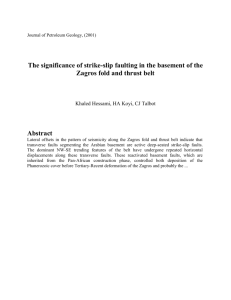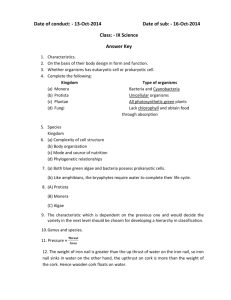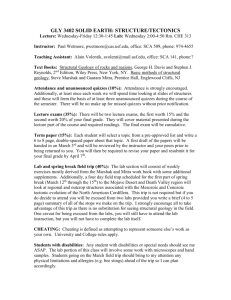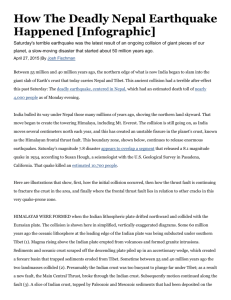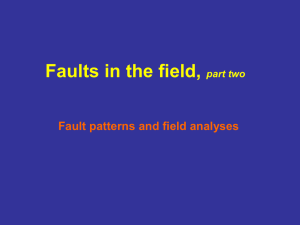Thrust
advertisement
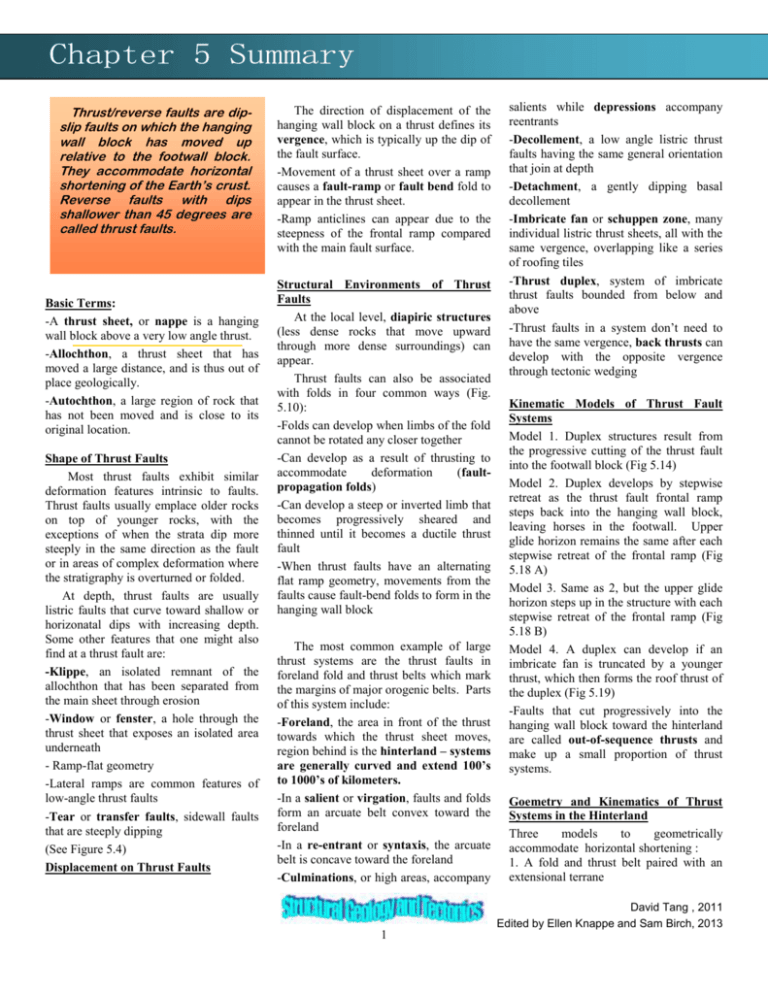
Thrust/reverse faults are dipslip faults on which the hanging wall block has moved up relative to the footwall block. They accommodate horizontal shortening of the Earth’s crust. Reverse faults with dips shallower than 45 degrees are called thrust faults. Basic Terms: -A thrust sheet, or nappe is a hanging wall block above a very low angle thrust. -Allochthon, a thrust sheet that has moved a large distance, and is thus out of place geologically. -Autochthon, a large region of rock that has not been moved and is close to its original location. Shape of Thrust Faults Most thrust faults exhibit similar deformation features intrinsic to faults. Thrust faults usually emplace older rocks on top of younger rocks, with the exceptions of when the strata dip more steeply in the same direction as the fault or in areas of complex deformation where the stratigraphy is overturned or folded. At depth, thrust faults are usually listric faults that curve toward shallow or horizonatal dips with increasing depth. Some other features that one might also find at a thrust fault are: -Klippe, an isolated remnant of the allochthon that has been separated from the main sheet through erosion -Window or fenster, a hole through the thrust sheet that exposes an isolated area underneath - Ramp-flat geometry -Lateral ramps are common features of low-angle thrust faults -Tear or transfer faults, sidewall faults that are steeply dipping (See Figure 5.4) Displacement on Thrust Faults The direction of displacement of the hanging wall block on a thrust defines its vergence, which is typically up the dip of the fault surface. -Movement of a thrust sheet over a ramp causes a fault-ramp or fault bend fold to appear in the thrust sheet. -Ramp anticlines can appear due to the steepness of the frontal ramp compared with the main fault surface. Structural Environments of Thrust Faults At the local level, diapiric structures (less dense rocks that move upward through more dense surroundings) can appear. Thrust faults can also be associated with folds in four common ways (Fig. 5.10): -Folds can develop when limbs of the fold cannot be rotated any closer together -Can develop as a result of thrusting to accommodate deformation (faultpropagation folds) -Can develop a steep or inverted limb that becomes progressively sheared and thinned until it becomes a ductile thrust fault -When thrust faults have an alternating flat ramp geometry, movements from the faults cause fault-bend folds to form in the hanging wall block The most common example of large thrust systems are the thrust faults in foreland fold and thrust belts which mark the margins of major orogenic belts. Parts of this system include: -Foreland, the area in front of the thrust towards which the thrust sheet moves, region behind is the hinterland – systems are generally curved and extend 100’s to 1000’s of kilometers. -In a salient or virgation, faults and folds form an arcuate belt convex toward the foreland -In a re-entrant or syntaxis, the arcuate belt is concave toward the foreland -Culminations, or high areas, accompany 1 salients while depressions accompany reentrants -Decollement, a low angle listric thrust faults having the same general orientation that join at depth -Detachment, a gently dipping basal decollement -Imbricate fan or schuppen zone, many individual listric thrust sheets, all with the same vergence, overlapping like a series of roofing tiles -Thrust duplex, system of imbricate thrust faults bounded from below and above -Thrust faults in a system don’t need to have the same vergence, back thrusts can develop with the opposite vergence through tectonic wedging Kinematic Models of Thrust Fault Systems Model 1. Duplex structures result from the progressive cutting of the thrust fault into the footwall block (Fig 5.14) Model 2. Duplex develops by stepwise retreat as the thrust fault frontal ramp steps back into the hanging wall block, leaving horses in the footwall. Upper glide horizon remains the same after each stepwise retreat of the frontal ramp (Fig 5.18 A) Model 3. Same as 2, but the upper glide horizon steps up in the structure with each stepwise retreat of the frontal ramp (Fig 5.18 B) Model 4. A duplex can develop if an imbricate fan is truncated by a younger thrust, which then forms the roof thrust of the duplex (Fig 5.19) -Faults that cut progressively into the hanging wall block toward the hinterland are called out-of-sequence thrusts and make up a small proportion of thrust systems. Goemetry and Kinematics of Thrust Systems in the Hinterland Three models to geometrically accommodate horizontal shortening : 1. A fold and thrust belt paired with an extensional terrane David Tang , 2011 Edited by Ellen Knappe and Sam Birch, 2013 2. Root zone model 3. Subduction model Analysis of Displacement on Thrust Faults Determine displacement direction shear sense, and amount of displacement through use of maps and cross sections (Fig 23). It is best to use more than one method to determine displacement. A palinspastic cross section is one that has restored the geology, geographic features, and tectonic features as nearly as possible to their configuration that preceded deformation References & Resources Robert J. Twiss, Eldridge M. Moores, Structural Geology 2nd edition, (W. H. Freeman), p. 135-150, 2006 David Tang , 2011 Edited by Ellen Knappe and Sam Birch, 2013 2

